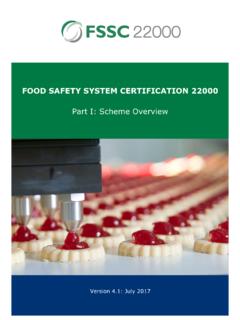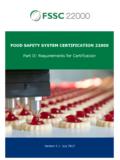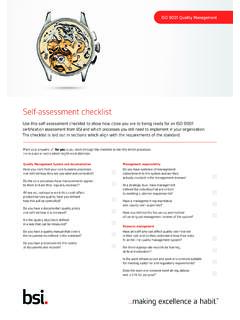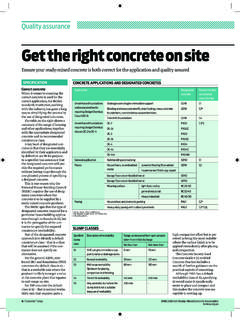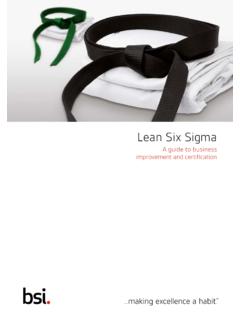Transcription of Risk Management In ISO 9000 Series Standards - Fish
1 RISK Management IN ISO 9000 Series Standards Evgeny Avanesov Working Party on Regulatory Cooperation and Standardization Policies ECONOMIC COMMISSION FOR EUROPE Groupe de travail des politiques de coop ration en mati re de r glementation et de normalisation COMMISSION CONOMIQUE POUR L EUROPE Рабочая группа по политике в области стандартизации и сотрудничества по вопросам нормативного регулирования ЕВРОПЕЙСКАЯ ЭКОНОМИЧЕСКАЯ КОМИССИЯ The papers carry the names of the authors and should be cited accordingly. The findings, interpretations, and conclusions expressed in this paper are entirely those of the authors. They do not necessarily represent the views of the United Nations, or those of the governments they represent. The Authors. All rights reserved. No part of this paper may be reproduced without the permission of the authors.
2 RISK Management IN ISO 9000 Series Standards Evgeny Avanesov , Member of Russian delegation in ISO/TС 176, ISO/TC 207 Introduction The international community has developed a number of documents in some way related to the standardization of approaches to risk Management . The International Organization for Standardization (ISO), together with the International Electrotechnical Commission (IEC) are the lead organizations in the development of international Standards . Some national standardization bodies and non-governmental organizations also have contributed to the development and use of standardized approaches to risk Management . The most important national and international Standards for the risk Management Producer Name ISO/IEC ISO/FDIS 31000:2009 Risk Management -- Principles and guidelines ISO/IEC Guide 73:2002 Risk Management Vocabulary Guidelines for use in Standards ISO/IEC Guide 51:1999 Safety aspects Guidelines for their inclusion in Standards ISO 14971:2000 Medical devices Application of risk Management to medical devices ISO 17776:2000 Petroleum and natural gas industries Offshore production installation Guidelines on tools and techniques for hazard identification and risk assessment CSA CSA Q 850:1997 Risk Management Guidelines for Decision Makers JSA JIS Q 2001.
3 2001 Guidelines for development and implementation of risk Management system AS/NZS AS/NZS 4360:2004 Risk Management BSI PAS 56:2003 Guide to Business Continuity BS 31100:2008 Code of practice for risk Management BS 6079-3 Project Management - Part3: Guide to the Management of business related project risk PD6668 Managing Risk for Corporate Governance N ONR 49000 Risk Management for organizations and systems Terms and principles ONR 49001 Risk Management for organizations and systems Elements of the risk Management systems ONR 49002-1 Risk Management for organizations and systems Part 1: Guidelines for risk Management ONR 49002-2 Risk Management for organizations and systems Part 2: Guidelines for the integration of risk Management into the general Management system ONR 49003 Risk Management for organizations and systems ONORM S 2300 Risk, security and crisis Management Concepts ONORM S 2310 Risk, security and crisis Management Selection and verification criteria for persons appointed for crisis Management There is also a document issued by the Institute of Risk Management (IRM), Association of Insurance and Risk Managers (AIRMIC) - A Risk Management Standard (2002).
4 This is an incomplete list, and I apologize if some of the other papers on this topic are not pointed out. A little bit of focus on two documents: The efforts of ISO and IEC has led to appearance of ISO/IEC Guide 73:2002 Risk Management - Vocabulary-guidelines for use in Standards . This paper aims to provide members of ISO and IEC, government and non-governmental organizations involved in standardization at the international, regional and national levels, a set of basic definitions and terminology relating to risk Management . The need for a particular guidance document on the use of ideology and technology of risk Management within the framework of Standards has been recognized some time ago, based on the fact that many of the technical committees and working groups, ISO or IEC address the issue of risk Management in different manner.
5 And, Guide 73, finally, provides a general framework for incorporating risk Management in international Standards . However, despite the availability of terminology document ISO/IEC Guide 73:2002, a synthesis ISO standard that ensures a consistent approach to risk Management , is still lacking. This can lead to confusion among users of documents relating to the interpretation and practical application. The global economic situation, the practice of the business community in this area pushed ISO to expedite finalization of the international standard for risk Management . I say about the forthcoming ISO 31000:2009 Risk Management -- Principles and guidelines. As can be seen from the Draft, the new standard will provide vision, guidance, and generic iterative process of risk Management in organizations of any size. The standard is designed to be a document higher level, to ensure support for existing Standards .
6 Therefore, ISO 31000:2009 is not specific to any industry or sector. ISO 31000:2009 can be applied to any type of risk, whatever its nature, whether having positive or negative consequences. Although ISO 31000:2009 provides generic guidelines, it is not intended to promote uniformity of risk Management across organizations. An important thing that ISO 31000:2009 is not intended for the purpose of certification. But what about the risk Management theme in other generic Management system Standards ? The reflection of the risk Management Standards for Management systems I think that is not necessary to talk specifically about the importance of the ISO 9000 Series for the business community. This is the most popular product of the ISO using by more than one million companies worldwide. Using the process approach, which is proposed by standard ISO 9001:2008, for its activities, organizations are striving to meet the needs and expectations of both internal and external customers.
7 Quality Management is no longer the exclusive preserve of manufacturing companies, process approach has proven as an invaluable tool for service organizations, local authorities, health organizations, finance and transport. An additional benefit of working with ISO 9001: 2008 is the fact that the standard requires to improve the processes operating in the organization. Traditionally, the Quality Management system (QMS) is developed as follows. The basis for the development of QMS is some purpose of organization or its mission. How it can be formed - is not specified in the standard. Then they establish a Quality Policy of organization, which is deployed to objectives. All system is built on this framework to for the aim of fulfilling objectives. Risk Management has no place in this scheme. However, the risk approach method is an integral part of other generic Management systems Standards : Environmental Management Standard ISO 14001 and the Occupational Health & Safety Assessment Standard OHSAS 18001.
8 Organizations should identify and assess each of the risks they ve been faced. Infrequent risks with minor effects are shall be only controlled. Significant risks with severe consequences should be managed in such a way as to either completely eliminate them or reduce the frequency of their occurrence and severity of consequences. Organizations that have successfully applied the ISO 14001 Standards , conducting ongoing analysis of the environmental Management system, an integral part of which is the consideration of significant environmental aspects associated with air emissions, discharges into water, waste disposal, ground pollution, use of raw materials and natural resources and other environmental problems . The style of thinking and behavior of such organizations usually meets the expectations of stakeholders: risk Management and prevention of losses related to the environment.
9 Organizations that successfully use OHSAS 18001, identify hazards and carry out an assessment of the risks associated with routine activities, as well as the risk of presence of sub-contractors and visitors on the site. The key stakeholders are the people inside the organization, which creates a culture of risk Management . It is a pity that risk Management approach has not yet become one of the cornerstones of ISO 9001. The objective of business is to integrate this good practice and to apply it more broadly, including quality Management . In fact, along with the application process approach, it is obvious to use the same risk assessment process applied to the objects such as market trends, strategic directions of business development expertise, operational activities, consumer satisfaction with products and services. As a result of these two approaches, the organization may pay more attention to the needs and expectations of its customers and other stakeholders.
10 They also are in a better position in terms of environmental Management and concern for the health and safety in the workplace. The ISO 9000 Standards and risk Management . The new version of ISO 9001 was issued at the end of 2008. For the first time the introduction explicitly emphasizes, that the development of a quality Management system must take into account the environment in which the organization operates, changes in that environment, as well as risks associated with this environment. Then it states that ISO 9001 does not contain requirements in relation to other types of Management , in particular to environmental Management , Management of health and safety, financial Management or risk Management . Indeed, in the ISO 9001 you will not find a specific reference to risk Management ( identification, analysis, evaluation, action on the reduction or deletion, etc.)




